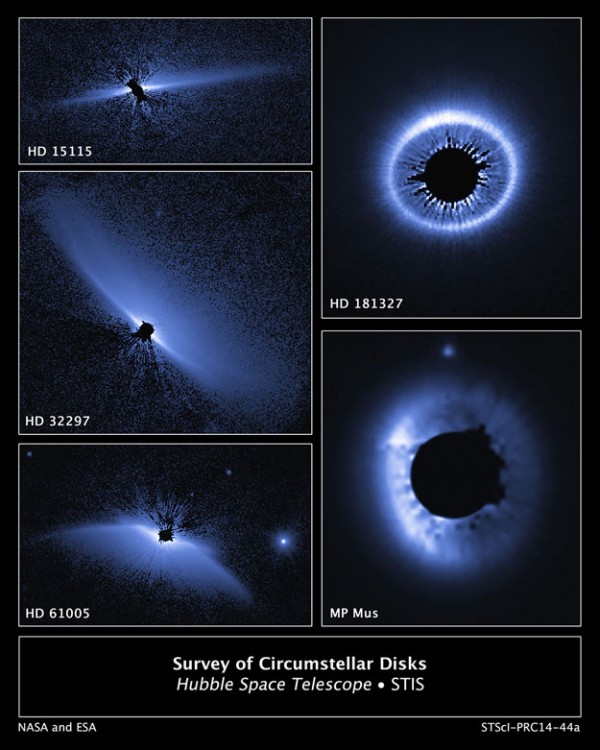NASA's Hubble Captures Amazing Images of Interstellar Debris Disks
| Ana Verayo | | Nov 10, 2014 01:52 AM EST |
(Photo : NASA/ESA/G. Schneider/U. Arizona) Photos from a NASA Hubble Space Telescope visible-light survey of the architecture of debris systems around young stars.
The Hubble space telescope had just finished a visible light imaging survey of dusty debris disks located around stars. Astronomers believe the debris to be remnants from planetary collisions.
The orbiting telescope captured images of debris disks shrouding young stars aged 10 million years and older stars aged 1 billion years. Astronomers have consolidated this data for this survey.
Like Us on Facebook
A surprising look into these pancake-like structures shows variations and diversity that suggests these dusty disks are also complex and are apparently being pulled by gravitational forces from unseen planets orbiting these stars.
According to survey leader, Glenn Schneider from the University of Arizona, this process is like a journey back in time, witnessing these cosmic destructions during the evolution of the solar system and how planets were formed.
Researchers noted that no two disks are the same. Each dusty disk is as unique as a human fingerprint.
Schneider also details these star disk systems aren't just flat surfaces but are complex three dimensional cosmic debris structures embedded with smaller systems inside them. Those sub-interstellar dust disks could be caused by unseen planets.
One star called HD 181327 has a massive spray forming a ring made of dust and debris that spans to its outskirts. Researchers think this may be a result of a recent collision of two planets.
According to co-investigator Christopher Stark from NASA's Goddard Space Flight Center, this spray is made from material that doesn't originate from its host star as it spans massive distances comparable to the distance of Pluto from the Sun.
This spray could very well be remnants from a destruction of two bodies but this large distance is hard to explain. Scientists compare this event to the formation of the Moon. They theorize the Moon was formed when a protoplanet collided withthe Earth billions of years ago.
Another theory for these unique dusty disks around stars is an unseen material or force emanating from star systems as the stars travel through interstellar space.
Only about two dozen star debris systems were captured by Hubble. Others exude 100,000 times fainter light than other brighter stars among interstellar systems.
TagsNASA's Hubble Captures Amazing Images of Interstellar Debris Disks, NASA, hubble telescope, debris disks, interstellar dust debris disks stars NASA hubble
©2015 Chinatopix All rights reserved. Do not reproduce without permission
EDITOR'S PICKS
-

Did the Trump administration just announce plans for a trade war with ‘hostile’ China and Russia?
-

US Senate passes Taiwan travel bill slammed by China
-

As Yan Sihong’s family grieves, here are other Chinese students who went missing abroad. Some have never been found
-

Beijing blasts Western critics who ‘smear China’ with the term sharp power
-

China Envoy Seeks to Defuse Tensions With U.S. as a Trade War Brews
-

Singapore's Deputy PM Provides Bitcoin Vote of Confidence Amid China's Blanket Bans
-

China warns investors over risks in overseas virtual currency trading
-

Chinese government most trustworthy: survey
-

Kashima Antlers On Course For Back-To-Back Titles
MOST POPULAR
LATEST NEWS
Zhou Yongkang: China's Former Security Chief Sentenced to Life in Prison

China's former Chief of the Ministry of Public Security, Zhou Yongkang, has been given a life sentence after he was found guilty of abusing his office, bribery and deliberately ... Full Article
TRENDING STORY

China Pork Prices Expected to Stabilize As The Supplies Recover

Elephone P9000 Smartphone is now on Sale on Amazon India

There's a Big Chance Cliffhangers Won't Still Be Resolved When Grey's Anatomy Season 13 Returns

Supreme Court Ruled on Samsung vs Apple Dispute for Patent Infringement

Microsoft Surface Pro 5 Rumors and Release Date: What is the Latest?










